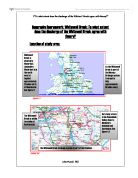Plateau
The plateau is the source of Burbage Brook, which is a fairly large are of high flat land.
This is formed by heavy rainfall soaking into the peat, which then filters into the brook.
Upper Burbage Brook
The upper area of Burbage Brook is a 'V-shape' with very steep sides.
This is caused due to the steep gradient of the riverbed that then leads to a high velocity of the river causing rapid vertical erosion to take place (refer to the bar chart to explain the velocity of upper Burbage Bridge.) This combined with weathering creates a 'V-shape' valley.
Deposition here is very minimal, as it is only the first flowing currents.
The type of weathering that you are likely to find at this area of the valley is 'freeze-thaw weathering'. This is when water gets into the cracks in the rock, expands (freezes) which then puts pressure on the rock eventually causing chunks of the rock to break off leading to a form of mass movement (Rock Creep).
The plateau is the source of Burbage Brook, which is a fairly large are of high flat land.
This is formed by heavy rainfall soaking into the peat, which then filters into the brook.
Upper Burbage Brook
The upper area of Burbage Brook is a 'V-shape' with very steep sides.
This is caused due to the steep gradient of the riverbed that then leads to a high velocity of the river causing rapid vertical erosion to take place (refer to the bar chart to explain the velocity of upper Burbage Bridge.) This combined with weathering creates a 'V-shape' valley.
Deposition here is very minimal, as it is only the first flowing currents.
The type of weathering that you are likely to find at this area of the valley is 'freeze-thaw weathering'. This is when water gets into the cracks in the rock, expands (freezes) which then puts pressure on the rock eventually causing chunks of the rock to break off leading to a form of mass movement (Rock Creep).







